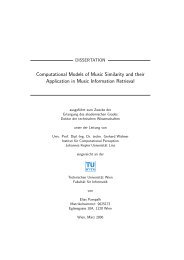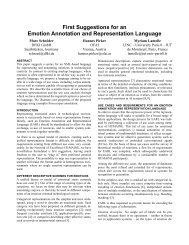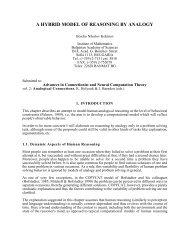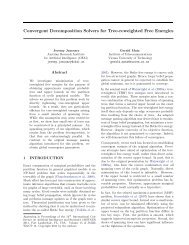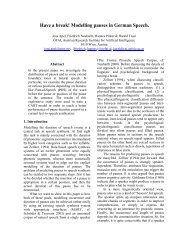Global Musical Tempo Transformations using Case Based ... - OFAI
Global Musical Tempo Transformations using Case Based ... - OFAI
Global Musical Tempo Transformations using Case Based ... - OFAI
Create successful ePaper yourself
Turn your PDF publications into a flip-book with our unique Google optimized e-Paper software.
the Retrieve task relies heavily on the case base organization for effectivity<br />
and efficiency of the task (although all tasks can potentially involve interaction<br />
with the the case base). A common way of structuring the case base<br />
is based on Schank’s dynamic memory model mentioned above [104, 70]).<br />
In this approach the case base is represented as an indexical tree-structure<br />
where the retrieval of cases takes place by traversing the tree from the root<br />
to a leaf, at each node taking the branch that has input features corresponding<br />
to those of the current problem. This approach has been rejected by<br />
Thagard and Holyoak [114], mainly because of its lack of psychological plausibility.<br />
In turn, they propose a theory for analogy that allows for making<br />
inter-domain mappings (rather than intra-domain mappings, as is usual in<br />
CBR). In their theory mapping is a result of semantic, structural and pragmatic<br />
constraints [61].<br />
3.3.2 The Retrieve Task<br />
The Retrieve task consists in finding a matching case, given a problem (or<br />
rather, an input description, specifying the problem situation and the requirements<br />
that a solution should fulfill). Retrieval methods can range from<br />
matching cases with only superficial similarities to the problem description,<br />
to matching based on a semantic analysis of the input description. The latter<br />
case typically requires a large amount of domain knowledge and is therefore<br />
called Knowledge-Intensive CBR (KI-CBR, see section 3.4). The Retrieve<br />
task in general can be divided into three subtasks: identify, match and select,<br />
which will be described in turn.<br />
Identify<br />
The aim of this subtask is to identify relevant features of the input description.<br />
In a “knowledge-poor” approach, the features of the input description<br />
might be just the input description itself (or some part of it). A<br />
“knowledge-intensive” approach might involve deriving abstract, or higher<br />
level features from the input description, discarding noisy parts of the description,<br />
and predicting unknown features of the input description, by <strong>using</strong><br />
domain-knowledge.<br />
As an example of the Identify subtask we can see how this task is performed<br />
in <strong>Tempo</strong>-Express [52], a CBR system for tempo-transformations<br />
preserving musical expression that we have developed (see chapter 5). In<br />
this system, the input problem description is formed by a representation of<br />
a melody, a performance of that melody at a particular tempo (T i ), and<br />
a desired tempo at which the melody is to be performed (T o ). The prob-<br />
36




